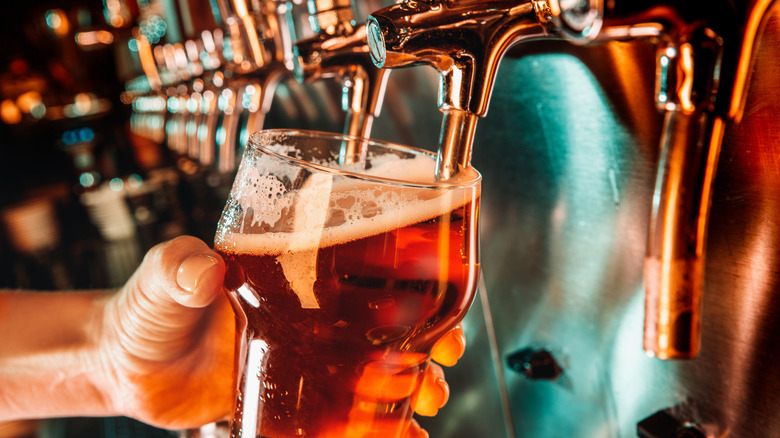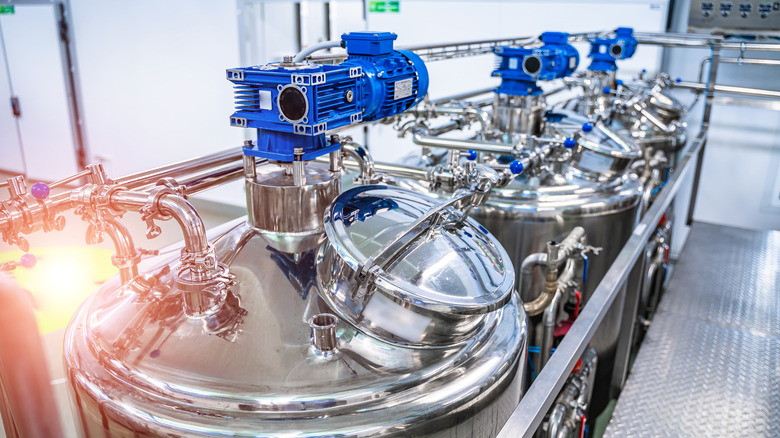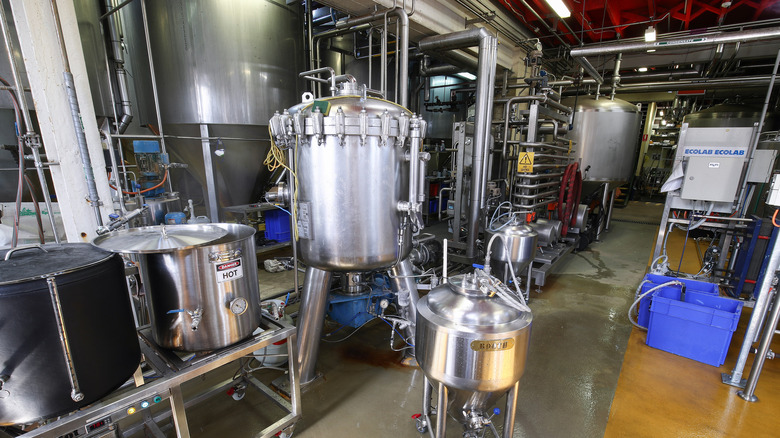The 2 Ways Low-Alcohol Beer Is Manufactured
As beer expert John Hall reminisced (via NPR), "The non-alcoholic beers of the past tasted like punishment." Maybe you got into homebrewing during the pandemic. Maybe you became a mocktail mixologist. Whatever the case, low-alcohol beer is having a moment right now: According to Global Market Insights, the U.S. non-alcoholic beer market surpassed $9.5 billion in 2019, and is projected to see a steady compound annual growth rate of 7.5% between now and 2026.
Believe it or not, non-alcoholic beer is pretty similar to full-alcohol options: they're both manufactured the same way. Per the brewing pros at About Alcohol, beer is made from a brewed combination of water, yeast, fermented malt grain, and hops — cone-like flowers that give beer its unique taste and fragrance. The malt is mashed into a pasty consistency called wort, and the wort is then fermented with the yeast. Non-alcoholic beers go through the same brewing process, but additional steps come in at the end to remove the alcohol content.
However, FDA guidelines state that non-alcoholic beer can contain up to 0.5% ABV, so your non-alcoholic brew might be more aptly labeled as a low-alcohol beer. Still, stripping away the alcohol content from a batch of beer is a brewmaster's craft science. So, how do they do it?
It's getting hot in here
Brewers most commonly strip the alcohol from beer by heating it up so the alcohol evaporates off. However, heating beer can significantly alter its flavor profile, according to Stuart Henshall, co-owner of a totally alcohol-free spirits bar in Melbourne, Victoria, Australia (per ABC Everyday). Many brewers, Henshall says, have gotten around this hurdle by using the vacuum-distilling method.
To stave off those flavor-warping effects, beer is placed in a vacuum-sealed chamber that lowers its boiling point, meaning the alcohol in the beer doesn't require such high, taste-altering temperatures to boil off. As Renegade Brewing notes, the key to vacuum distillation is low pressure.
Ethanol, the type of alcohol found in beer, typically has a boiling point of 173 degrees Fahrenheit (via Encyclopedia Britannica), much lower than that of water at 212 F. But, with vacuum distillation, beer chemist and owner of Oregon BrewLab, Dana Garves, reports that brewers can get the alcohol to evaporate off at even lower temperature — as low as 68 degrees, per NPR.
Filtration station
According to Drinkaware, many manufacturers choose to remove the alcohol in non-alcoholic or low-alcohol beer via filtration. The scientists at ThoughtCo., in discussing miscibility of fluids, explain that ethanol molecules are smaller than water molecules so, when mixed, the smaller ethanol molecules slip through the spaces between the larger water molecules, resulting in a mixture and a slightly smaller total volume.
Bill Schufelt, co-founder of craft non-alcoholic beer brand Athletic Brewing Company, explains how this science translates to the brewing of low-alcohol beers. In filtration, Schufelt says via Popular Mechanics, the beer is passed through a fine semipermeable membrane at a high-pressure velocity. The membrane only allows (the mix of) alcohol and water to pass through, so the beer is separated from the solution. Then, the alcohol is heated off of the water (remember, alcohol boils at a lower degree, 173 F, than water, 212 F); the water content is then recombined with the beer.
But, this beer filtration method does come with one extra step: beer becomes flat once the alcohol is removed, per Healthline. To fix this, brewers must reintroduce carbon dioxide at the end of the process so they don't end up with a flat batch of non-alcoholic or low-alcohol beer.


